牛津深圳版英语七年级上册 Unit 3 The Earth(1)导学案(含答案)
文档属性
| 名称 | 牛津深圳版英语七年级上册 Unit 3 The Earth(1)导学案(含答案) | 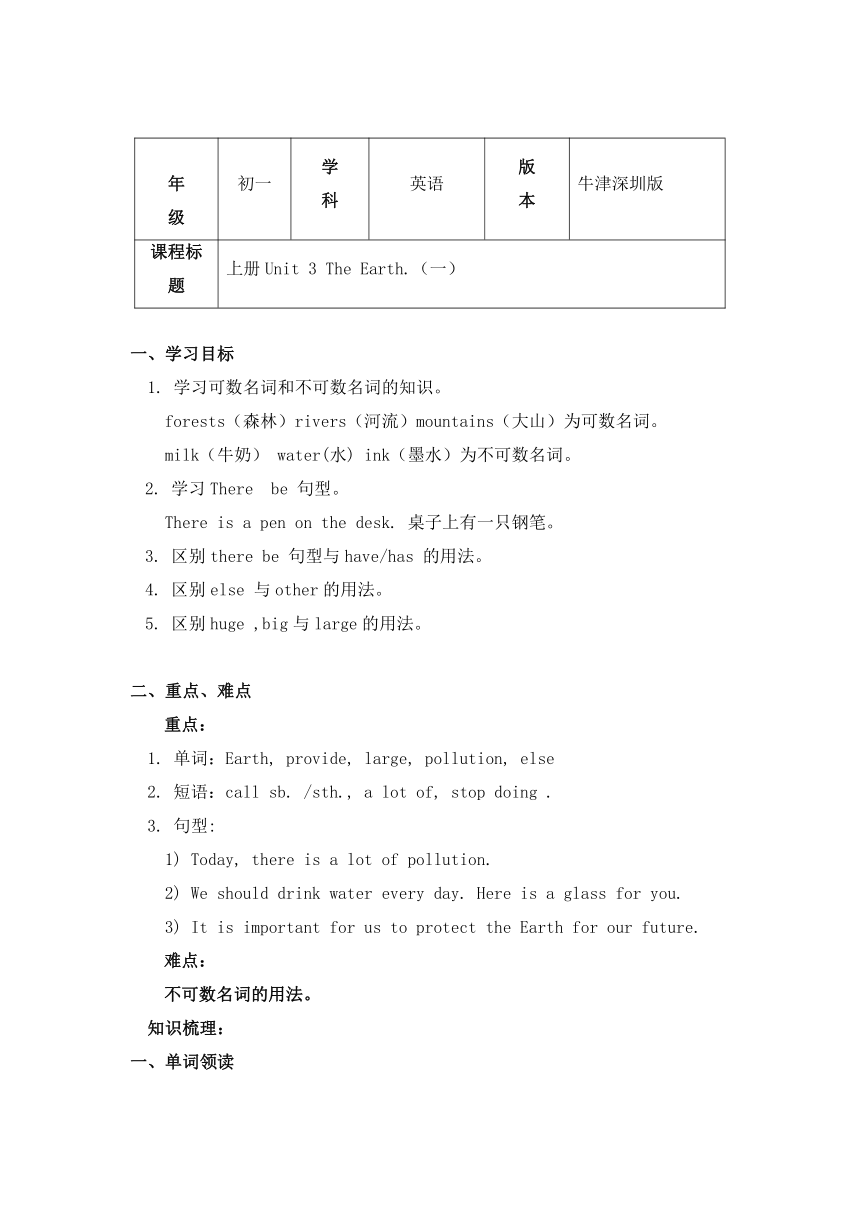 | |
| 格式 | doc | ||
| 文件大小 | 788.3KB | ||
| 资源类型 | 教案 | ||
| 版本资源 | 牛津深圳版 | ||
| 科目 | 英语 | ||
| 更新时间 | 2021-09-17 10:19:52 | ||
图片预览

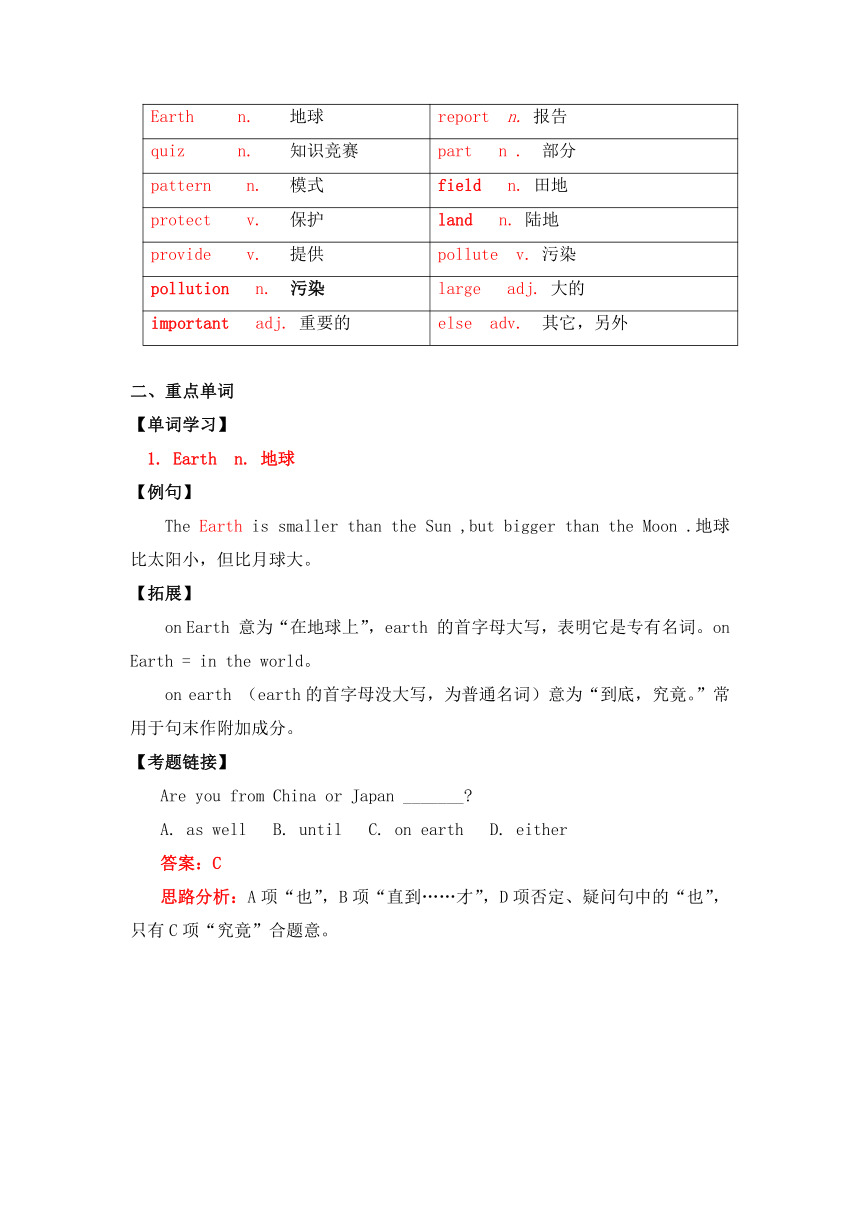
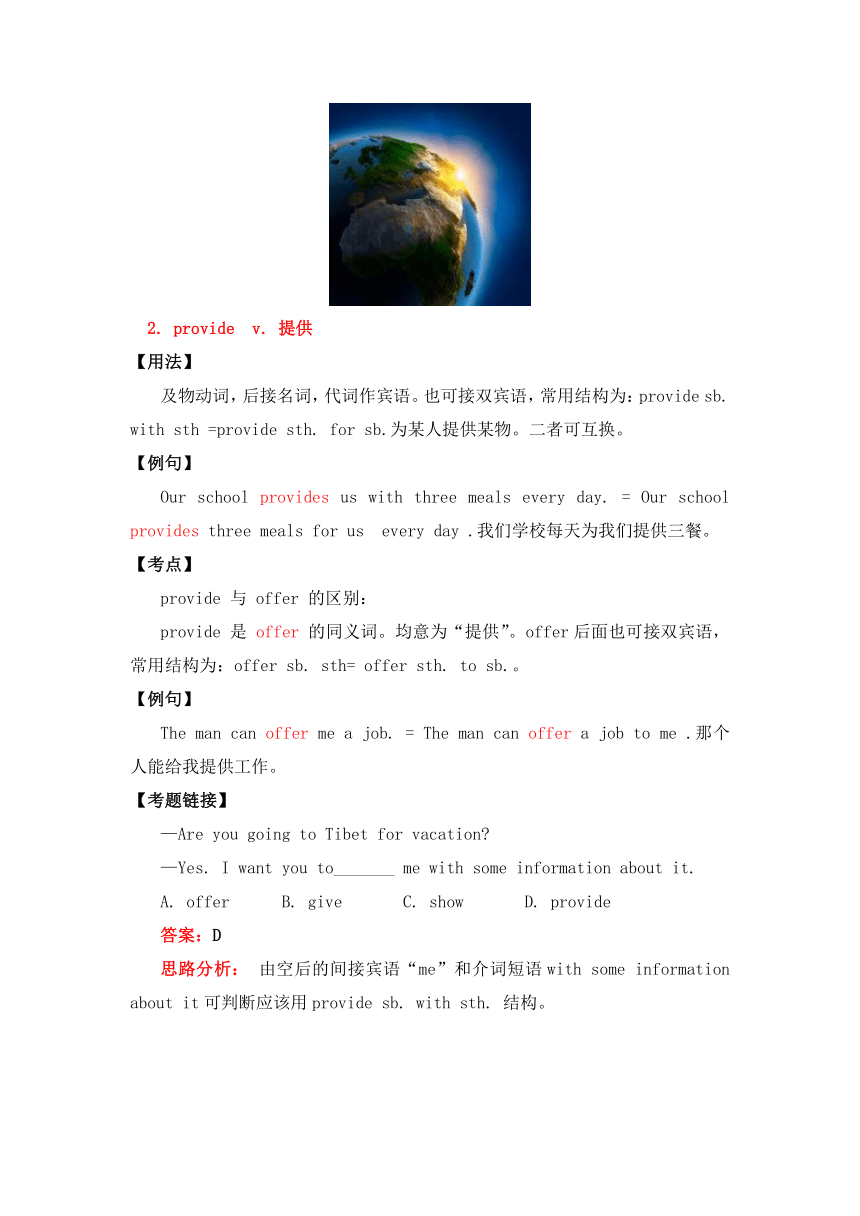
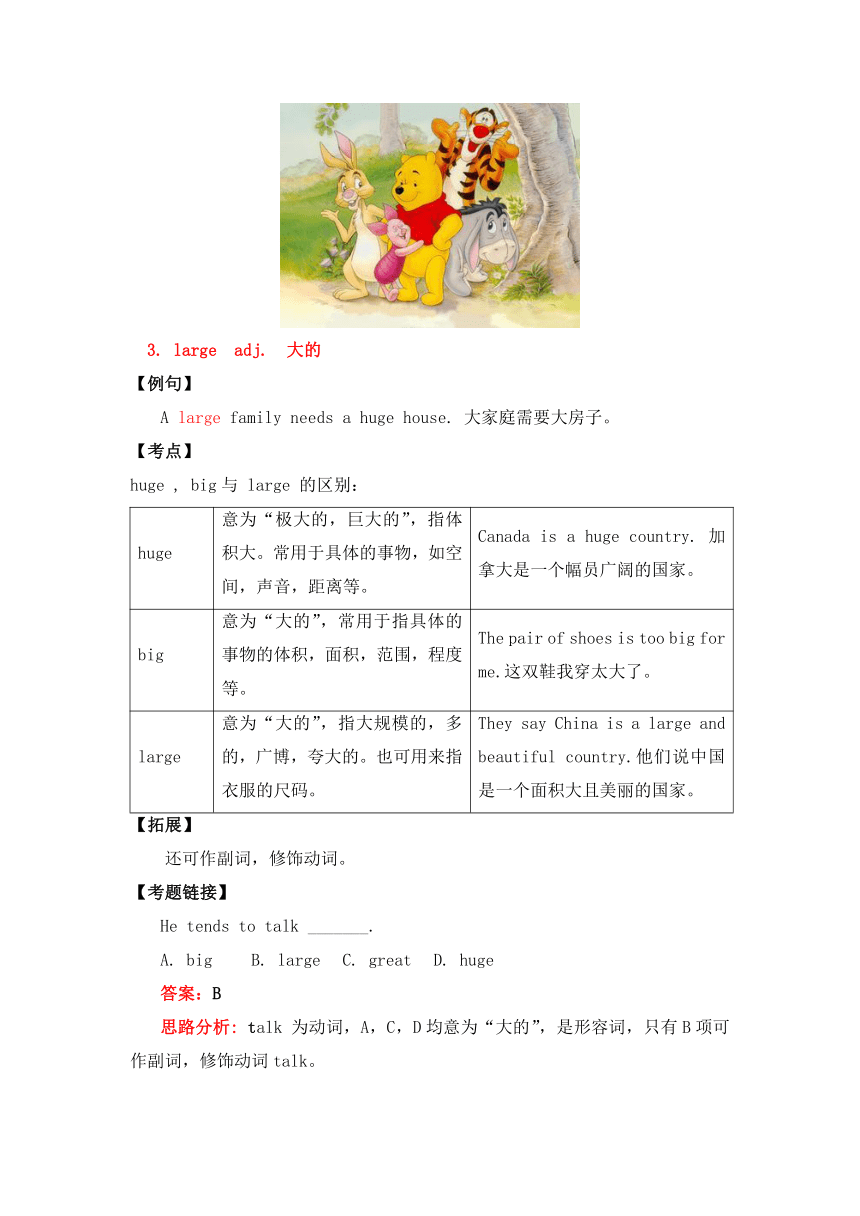
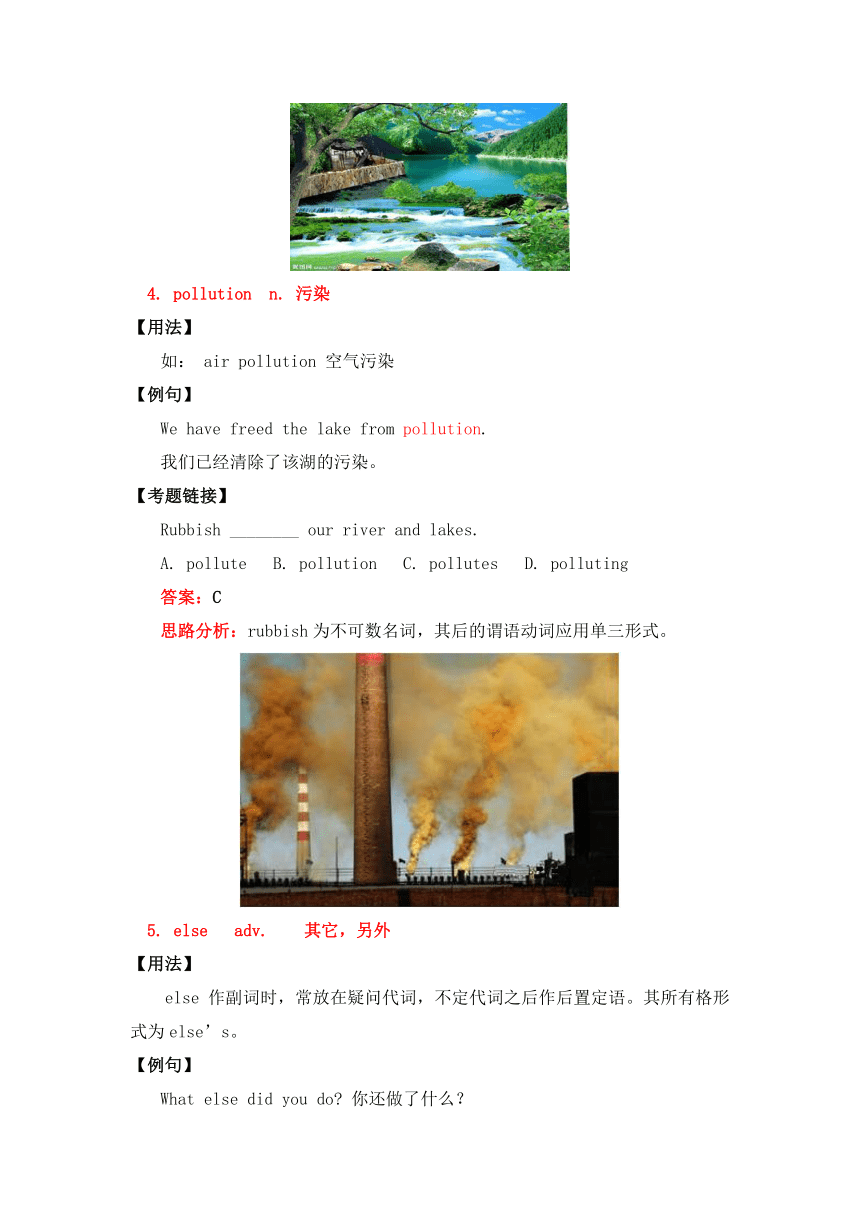
文档简介
年
级
初一
学
科
英语
版
本
牛津深圳版
课程标题
上册Unit
3
The
Earth.(一)
一、学习目标
1.
学习可数名词和不可数名词的知识。
forests(森林)rivers(河流)mountains(大山)为可数名词。
milk(牛奶)
water(水)
ink(墨水)为不可数名词。
2.
学习There
be
句型。
There
is
a
pen
on
the
desk.
桌子上有一只钢笔。
3.
区别there
be
句型与have/has
的用法。
4.
区别else
与other的用法。
5.
区别huge
,big与large的用法。
二、重点、难点
重点:
1.
单词:Earth,
provide,
large,
pollution,
else
2.
短语:call
sb.
/sth.,
a
lot
of,
stop
doing
.
3.
句型:
1)
Today,
there
is
a
lot
of
pollution.
2)
We
should
drink
water
every
day.
Here
is
a
glass
for
you.
3)
It
is
important
for
us
to
protect
the
Earth
for
our
future.
难点:
不可数名词的用法。
知识梳理:
一、单词领读
Earth
n.
地球
report
n.
报告
quiz
n.
知识竞赛
part
n
.
部分
pattern
n.
模式
field
n.
田地
protect
v.
保护
land
n.
陆地
provide
v.
提供
pollute
v.
污染
pollution
n.
污染
large
adj.
大的
important
adj.
重要的
else
adv.
其它,另外
二、重点单词
【单词学习】
1.
Earth
n.
地球
【例句】
The
Earth
is
smaller
than
the
Sun
,but
bigger
than
the
Moon
.地球比太阳小,但比月球大。
【拓展】
on
Earth
意为“在地球上”,earth
的首字母大写,表明它是专有名词。on
Earth
=
in
the
world。
on
earth
(earth的首字母没大写,为普通名词)意为“到底,究竟。”常用于句末作附加成分。
【考题链接】
Are
you
from
China
or
Japan
_______?
A.
as
well
B.
until
C.
on
earth
D.
either
答案:C
思路分析:A项“也”,B项“直到……才”,D项否定、疑问句中的“也”,只有C项“究竟”合题意。
2.
provide
v.
提供
【用法】
及物动词,后接名词,代词作宾语。也可接双宾语,常用结构为:provide
sb.
with
sth
=provide
sth.
for
sb.为某人提供某物。二者可互换。
【例句】
Our
school
provides
us
with
three
meals
every
day.
=
Our
school
provides
three
meals
for
us
every
day
.我们学校每天为我们提供三餐。
【考点】
provide
与
offer
的区别:
provide
是
offer
的同义词。均意为“提供”。offer后面也可接双宾语,常用结构为:offer
sb.
sth=
offer
sth.
to
sb.。
【例句】
The
man
can
offer
me
a
job.
=
The
man
can
offer
a
job
to
me
.那个人能给我提供工作。
【考题链接】
—Are
you
going
to
Tibet
for
vacation?
—Yes.
I
want
you
to_______
me
with
some
information
about
it.
A.
offer
B.
give
C.
show
D.
provide
答案:D
思路分析:
由空后的间接宾语“me”和介词短语with
some
information
about
it可判断应该用provide
sb.
with
sth.
结构。
3.
large
adj.
大的
【例句】
A
large
family
needs
a
huge
house.
大家庭需要大房子。
【考点】
huge
,
big与
large
的区别:
huge
意为“极大的,巨大的”,指体积大。常用于具体的事物,如空间,声音,距离等。
Canada
is
a
huge
country.
加拿大是一个幅员广阔的国家。
big
意为“大的”,常用于指具体的事物的体积,面积,范围,程度等。
The
pair
of
shoes
is
too
big
for
me.这双鞋我穿太大了。
large
意为“大的”,指大规模的,多的,广博,夸大的。也可用来指衣服的尺码。
They
say
China
is
a
large
and
beautiful
country.他们说中国是一个面积大且美丽的国家。
【拓展】
还可作副词,修饰动词。
【考题链接】
He
tends
to
talk
_______.
A.
big
B.
large
C.
great
D.
huge
答案:B
思路分析:
talk
为动词,A,C,D均意为“大的”,是形容词,只有B项可作副词,修饰动词talk。
4.
pollution
n.
污染
【用法】
如:
air
pollution
空气污染
【例句】
We
have
freed
the
lake
from
pollution.
我们已经清除了该湖的污染。
【考题链接】
Rubbish
________
our
river
and
lakes.
A.
pollute
B.
pollution
C.
pollutes
D.
polluting
答案:C
思路分析:rubbish为不可数名词,其后的谓语动词应用单三形式。
5.
else
adv.
其它,另外
【用法】
else
作副词时,常放在疑问代词,不定代词之后作后置定语。其所有格形式为else’s。
【例句】
What
else
did
you
do?
你还做了什么?
【考点】
else与other
的区别:
other
作形容词时,用于修饰名词,但必须前置。other没有所有格形式。
【例句】
I
want
some
other
books.
我还要另外一些书。
【注意】
anything
else
=
any
other
thing;everybody
else
=
every
other
person
;
nobody
else
=
no
other
person。
【考题链接】
Put
it
down,
Tom.
You
mustn’t
read
____
letters.
A.
anyone
else’s
B.
anyone
other
C.
other
anyone
D.
else
anyone’s
答案:A
思路分析:
else与other都可以表示“别的,其它的”,但else常用在它所修饰的词的后面,other常用在它所修饰的词之前,疑问代词,不定代词后只能用else。
【即学即练】
I.
选出不同类别的单词:
(
)1.
A.
Earth
B.
Sun
C.
Moon
D.
land
(
)2.
A.
color
B.
white
C.
brown
D.
green
(
)3.
A.
forest
B.
ocean
C.
sea
D.
river
(
)4.
A.
big
B.
large
C.
huge
D.
size
(
)5.
A.
hot
B.
weather
C.
cold
D.
warm
II.
翻译短语:
1.
保护地球________________
2.
许多不同的植物________________
3.
在陆地上________________
4.
在空中________________________
5.
在地下__________________
6.
像你和我一样的人______________
7.
把……倒入______________
8.
污染地球______________________
III.
单选:
(
)1.
The
students
must
stop
______
in
class
when
the
teacher
is
speaking.
A.
to
talk
B.
talked
C.
talk
D.
talking
(
)2.
—I
think
we
should
keep
_______
in
the
reading-room.
—You
are
right.
A.
quiet
B.
quietly
C.
quite
D.
quickly
(
)3.
________
of
the
land
is
covered
_______
water.
A.
Two-third
,
by
B.
Two-three
,by
C.
Two-thirds
,with
D.
Two-third
,
with
(
)4.
.Everyone
knows
China
is
getting
_________.
A.
strong
and
strong
B.
stronger
and
stronger
C.
more
strong
and
strong
D.
strongest
and
strongest
答案:
I.
1—5
D
A
A
D
B
II.
1.
protect
the
Earth
2.
many
different
plants
3.
on
the
land
4.
in
the
sky
5.
under
the
ground
6.
people
like
you
and
me
7.
put...into...
8.
pollute
the
Earth
III.
1—4
D
A
C
B
三、重点短语
【短语学习】
1.
call
sb.
sth.
把某人称作……
【例句】
The
parents
call
the
baby
Tom.
父母给婴儿取名为汤姆。
【用法1】
call
作动词,“叫,呼唤”。
【例句】
Call
a
doctor
at
once.
快点叫个医生来。
【用法2】
call作动词,“认为,称为……”。
【例句】
We
called
this
a
success.
我们认为这是一件成功的事。
【用法3】
call
作动词,“给……打电话”。
【例句】
I
call
him
this
morning.
今天早晨我给他打了个电话。
【用法4】
call
作动词“邀请”。
【例句】
Will
you
call
the
family
to
dinner?
你会邀请那一家人来吃饭吗?
【用法5】
call作名词,“电话,通知”。
【例句】
I’ve
just
had
a
call
from
Tom.我刚刚接到汤姆打来的电话。
【注意】
含call
的常用短语有:
call
on
sb.
拜访某人;call
out大声喊叫;call
up
给……打电话;call
back回电话。
【考题链接】
Mother
asked
Mary
to
answer
the
________
for
her.
A.
call
B.
letter
C.
question.
答案:A
思路分析:句意:“妈妈让玛丽替她接电话”。B、C不符合题意。
2.
a
lot
of
许多,大量
【用法】
a
lot
of
=lots
of,既可修饰可数名词,也可修饰不可数名词。
【例句】
A
lot
of
countries
take
part
in
London
Olympics.
许多国家参加伦敦奥运会。
The
rich
man
has
a
lot
of
money,
but
he
isn’t
happy
every
day.
那位富人很有钱,但并不天天快乐。
【考题链接】
The
East
Lake
has
become
very
dirty.
_______
fish
have
died.
A.
Lot
B.
Many
C.
Lot
of
D.
Much
答案:B
思路分析:a
lot
of
所修饰的fish表复数,指鱼的种类,此时a
lot
of相当于many。
3.
stop
doing
停止做……
【用法】
stop
doing
sth.
停止正在做的某事
【例句】
Stop
singing!The
teacher
is
coming
.停止唱歌,老师来啦。
【拓展】
stop
to
do
sth.
意为“停下来(正在干的事)去做(另外的)某事。
【例句】
Stop
to
listen
to
me,
please.
同学们,停下来听我的。
【考题链接】
Class
is
beginning
.Please
stop
______.
A.
talking
B.
to
talk
C.
talk
答案:A
思路分析:句意“上课了,请停止说话”。停止正在做的事,所以用doing
形式。
【即学即练】
一、根据汉语提示写单词。
1.
I
can
see
many
_______
(星星)
in
the
sky
at
night.
2.
The
______
(月球)
is
smaller
than
the
Sun.
3.
We
must
do
something
to
protect
the
______
(地球).
4.
Let’s
learn
how
to
use
this
sentence
_______
(模式).
二、用括号里所给词的适当形式填空。
1.
The
weather
is
______
in
some
places.
(difference)
2.
We
must
stop
the
_______
of
our
beaches.
(pollute)
3.
Please
put
the
____
paper
into
the
box
over
there.
(use)
4.
When
the
class
begins,
we
should
stop_____
and
listen
to
the
teacher
carefully.
(talk)
三、同义句转换。
1.
The
Sears
is
the
tallest
building
on
Earth.
The
Sears
is
the
tallest
building
_____
_____
______.
2.
There
is
a
lot
of
pollution.
There
is
______
pollution.
3.
What
else
would
you
like?
What
_____
______
would
you
like?
4.
Sea
animals
share
the
oceans
with
us
as
well.
Sea
animals
share
the
oceans
with
us,
_____.
【答案】
一、1.
stars
2.
moon
3.
earth
4.
pattern
二、1.
different
2.pollution
3.
used
4.
talking
三、1.
in
the
world
2.
much
3.
other
things
4.too
四、重点句型
【句型学习】
1.
Today,
there
is
a
lot
of
pollution.
如今有许多污染。
【句析】
在there
be
句型中,
be
后的名词是句子的主语,因而be的数应该与该名词的数保持一致。当后面的名词不止一个时,be的数应该按“就近”原则来确定。
【例句】
There
is
some
milk
in
the
glass.
杯里有一些牛奶。
There
are
four
chairs,
a
able
and
a
small
bed
in
the
room.
房间里有四把椅子,一张桌子和一张小床。
【考点】
there
be
与
have
(has)
比较:
there
be
表示“某处存在某人或某物”。
have/has
表示“某人拥有某物”。
【例句】
I
have
a
pet
dog.
我有只宠物狗。
There
are
five
pens
in
the
pencil-box.
铅笔盒中有五支钢笔。
【注意】
当have/has
表示“包括有”或“存在”时,可与there
be互换。
【考题链接】
—There
is
some
soup
on
the
table,
isn’t
_____?
—No,
I
think
that’s
water.
A.
there
B.
it
C.
that
D.
one
答案:A
思路分析:there
be结构的反意疑问句应用
be
there结构。
2.
We
should
drink
water
every
day.
Here
is
a
glass
for
you.
我们应该每天喝水。给你个水杯。
【句析】
本句中出现了不可数名词water“水”和可数名词glass“水杯”。
可数名词:该名词所表示的人或事物可以用数来计量。常见的有:
apple,
banana,
pear
等。
不可数名词:该名词所表示的事物不能直接用数来计量。不可数名词前一般不用定冠词the
或不定冠词
a/an
。常见的有:rain雨,tea茶
,milk
牛奶,water
水等。
【例句】
There
is
some
tea
in
the
glass.
杯子里有一些茶。
【注意】
1.
不可数名词前不能直接加数词或a(n)。如:a
meat
(错),
two
tea
(错)。
2.
不可数名词无单复数变化,谓语动词一般用单数形式。
3.
不可数名词可以用much,
a
little,
a
bit,
some,
any,
a
lot
of
等来修饰。
4.
表示具体的数量时,常用下面的句式结构:“基数词+
单位名词+
of
+名词”。
a
piece
of
paper
一张纸
three
glasses
of
milk
三杯牛奶
【考题链接】
Some
food
on
the
table
____
bad.
A.
goes
B.
go
C.
to
go
D.
going
答案:A
思路分析:food为不可数名词,谓语动词用单数形式。
3.
It
is
important
for
us
to
protect
the
Earth
for
our
future.为了我们的未来,保护地球对于我们来说是很重要的。
【句析】
此句中it
为形式主语,不定式
to
protect
the
Earth
for
our
future
为真正的主语。
【例句】
It’s
useful
for
you
to
learn
how
to
use
the
computer.
学计算机对你很有用。
【拓展】
It
+
be
+
adj.
+
for
sb.
to
do
sth.
表示“做某事对某人来说是……的”。这一句型中形容词与for后的人物有主表关系,形容词仅仅是描述事物,不是对不定式行为者的品格进行评价。
It
+
be
+
adj.
+
of
sb.
to
do
sth.
表示“某人做某事是……的”。这一句型中形容词与of后的人物没有主表关系,形容词描述不定式行为者的性格、品质等。
【例句】
It
is
kind
of
you
to
come
to
see
me.
你来看望我真好。
【考题链接】
It
is
important
_____
us
to
learn
English
well.
A.
of
B.
with
C.
on
D.
for
答案:D
思路分析:句中人物“我们”与形容词“重要的”有主表关系,故选D。
【即学即练】
根据括号中的汉语提示完成句子。
1.
_______
_________(有)
a
book
and
two
pens
on
the
desk.
2.
_______
_________(有)
some
money
in
the
picture.
3.
_______
_________(有)
some
cards
in
Jim’s
bag.
4.
________
________(有)
anything
else
in
it?
5.
________
_______
________
(没有)
birds
in
the
tree
.
答案:
1.
There
is
2.
There
is
3.
There
are
4.
Is
there
5.There
are
no/There
aren’t
any
同步练习:
(答题时间:40分钟)
Ⅰ.
词组翻译
1.
两箱苹果_________
2.
九片面包________
3.
七袋大米________
4.
三张纸________
5.
五块肉________
6.
十杯水__________
Ⅱ.
用there
be或have/has填空
1.
This
desk
____
four
legs.
2.
_____
some
books
on
the
desk.
3.
Everyone
_______
a
dictionary
in
my
class.
4.
________
(没有)
knives
in
the
room.
5.
I
_____
a
new
sweater.
6.
______
nothing
in
the
bag.
Ⅲ.
汉译英
1.
这些地方的天气是不同的。
2.
所有的植物都需要光和水。
3.
地球上有许多不同的动物。
4.
对于我们来说,学好数学很重要。
5.
我们必须停止污染水。
Ⅳ.
综合阅读
The
Earth
is
a
beautiful
place.
There
are
forests
and
rivers,
mountains
and
fields.
Some
places
are
very
hot,
and
some
are
very
cold.
The
weather
is
A._______
in
these
places.
There
are
many
different
plants.
Some
are
large
.Some
are
small!
B.______
plants
need
light
and
water.
There
are
different
animals
on
Earth
C.
as
well.
Some
live
on
the
land
.Some
fly
in
the
sky
.Some
live
under
the
water.
There
are
also
D.
a
lot
of
people
like
you
and
me
on
Earth.
E
The
Earth
provides
us
with
air,
water
and
food.
It
is
our
home.
Today,
there
is
a
lot
of
pollution.
We
burn
things
to
make
energy.
F.
This
pollutes
the
air.
We
put
our
rubbish
into
the
sea
and
under
the
ground
.G
This
pollutes
the
Earth
and
kills
animals
and
plants.
We
must
stop
H.
做这些事情.
It
is
important
to
protect
the
Earth
for
our
future.
1.
在文中A和B的空白处分别填入适当的单词:_________
;__________
2.
写出文中划线部分C和D的同义词或近义词:_______
;__________
3.
将文中划线部分E改写为:The
Earth
_____
air
,water
and
food
____
us
.
4.
文中划线部分F和G分别指代:______
;________
5.
将文中划线部分H译成英语:____________
6.
从文中找出能说明本文主旨大意的中心句:__________
V.
用“There
is....”和“There
are
....”的句型各造五个句子。
___________________________________________________________________________________________________________________________________________________________________________________________________________________________________________________________________________________________________________________________________________________________________________________________________________
答案:
I.
1.
two
boxes
of
apples
2.
nine
pieces
of
bread
3.
seven
bags
of
rice
4.
three
pieces
of
paper
5.
five
pieces
of
meat
6.
ten
glasses
of
water
II.
1.
has
2.
There
are
3.
has
4.
There
aren’t
any/There
are
no
5.
have
6.
There
is
III.
1.
The
weather
is
different
in
these
places.
2.
All
plants
need
light
and
water.
3.
There
are
many
different
animals
on
Earth.
4.
It’s
very
important
for
us
to
learn
maths
well.
5.
We
must
stop
polluting
the
water.
IV.
1.different;
All
2.
too;
many
3.
provides,
for
4.
We
burn
things
to
make
energy;
We
put
our
rubbish
into
the
sea
and
under
the
ground.
5.
doing
these
things
6.
It
is
important
to
protect
the
Earth
for
our
future.
V.
略
级
初一
学
科
英语
版
本
牛津深圳版
课程标题
上册Unit
3
The
Earth.(一)
一、学习目标
1.
学习可数名词和不可数名词的知识。
forests(森林)rivers(河流)mountains(大山)为可数名词。
milk(牛奶)
water(水)
ink(墨水)为不可数名词。
2.
学习There
be
句型。
There
is
a
pen
on
the
desk.
桌子上有一只钢笔。
3.
区别there
be
句型与have/has
的用法。
4.
区别else
与other的用法。
5.
区别huge
,big与large的用法。
二、重点、难点
重点:
1.
单词:Earth,
provide,
large,
pollution,
else
2.
短语:call
sb.
/sth.,
a
lot
of,
stop
doing
.
3.
句型:
1)
Today,
there
is
a
lot
of
pollution.
2)
We
should
drink
water
every
day.
Here
is
a
glass
for
you.
3)
It
is
important
for
us
to
protect
the
Earth
for
our
future.
难点:
不可数名词的用法。
知识梳理:
一、单词领读
Earth
n.
地球
report
n.
报告
quiz
n.
知识竞赛
part
n
.
部分
pattern
n.
模式
field
n.
田地
protect
v.
保护
land
n.
陆地
provide
v.
提供
pollute
v.
污染
pollution
n.
污染
large
adj.
大的
important
adj.
重要的
else
adv.
其它,另外
二、重点单词
【单词学习】
1.
Earth
n.
地球
【例句】
The
Earth
is
smaller
than
the
Sun
,but
bigger
than
the
Moon
.地球比太阳小,但比月球大。
【拓展】
on
Earth
意为“在地球上”,earth
的首字母大写,表明它是专有名词。on
Earth
=
in
the
world。
on
earth
(earth的首字母没大写,为普通名词)意为“到底,究竟。”常用于句末作附加成分。
【考题链接】
Are
you
from
China
or
Japan
_______?
A.
as
well
B.
until
C.
on
earth
D.
either
答案:C
思路分析:A项“也”,B项“直到……才”,D项否定、疑问句中的“也”,只有C项“究竟”合题意。
2.
provide
v.
提供
【用法】
及物动词,后接名词,代词作宾语。也可接双宾语,常用结构为:provide
sb.
with
sth
=provide
sth.
for
sb.为某人提供某物。二者可互换。
【例句】
Our
school
provides
us
with
three
meals
every
day.
=
Our
school
provides
three
meals
for
us
every
day
.我们学校每天为我们提供三餐。
【考点】
provide
与
offer
的区别:
provide
是
offer
的同义词。均意为“提供”。offer后面也可接双宾语,常用结构为:offer
sb.
sth=
offer
sth.
to
sb.。
【例句】
The
man
can
offer
me
a
job.
=
The
man
can
offer
a
job
to
me
.那个人能给我提供工作。
【考题链接】
—Are
you
going
to
Tibet
for
vacation?
—Yes.
I
want
you
to_______
me
with
some
information
about
it.
A.
offer
B.
give
C.
show
D.
provide
答案:D
思路分析:
由空后的间接宾语“me”和介词短语with
some
information
about
it可判断应该用provide
sb.
with
sth.
结构。
3.
large
adj.
大的
【例句】
A
large
family
needs
a
huge
house.
大家庭需要大房子。
【考点】
huge
,
big与
large
的区别:
huge
意为“极大的,巨大的”,指体积大。常用于具体的事物,如空间,声音,距离等。
Canada
is
a
huge
country.
加拿大是一个幅员广阔的国家。
big
意为“大的”,常用于指具体的事物的体积,面积,范围,程度等。
The
pair
of
shoes
is
too
big
for
me.这双鞋我穿太大了。
large
意为“大的”,指大规模的,多的,广博,夸大的。也可用来指衣服的尺码。
They
say
China
is
a
large
and
beautiful
country.他们说中国是一个面积大且美丽的国家。
【拓展】
还可作副词,修饰动词。
【考题链接】
He
tends
to
talk
_______.
A.
big
B.
large
C.
great
D.
huge
答案:B
思路分析:
talk
为动词,A,C,D均意为“大的”,是形容词,只有B项可作副词,修饰动词talk。
4.
pollution
n.
污染
【用法】
如:
air
pollution
空气污染
【例句】
We
have
freed
the
lake
from
pollution.
我们已经清除了该湖的污染。
【考题链接】
Rubbish
________
our
river
and
lakes.
A.
pollute
B.
pollution
C.
pollutes
D.
polluting
答案:C
思路分析:rubbish为不可数名词,其后的谓语动词应用单三形式。
5.
else
adv.
其它,另外
【用法】
else
作副词时,常放在疑问代词,不定代词之后作后置定语。其所有格形式为else’s。
【例句】
What
else
did
you
do?
你还做了什么?
【考点】
else与other
的区别:
other
作形容词时,用于修饰名词,但必须前置。other没有所有格形式。
【例句】
I
want
some
other
books.
我还要另外一些书。
【注意】
anything
else
=
any
other
thing;everybody
else
=
every
other
person
;
nobody
else
=
no
other
person。
【考题链接】
Put
it
down,
Tom.
You
mustn’t
read
____
letters.
A.
anyone
else’s
B.
anyone
other
C.
other
anyone
D.
else
anyone’s
答案:A
思路分析:
else与other都可以表示“别的,其它的”,但else常用在它所修饰的词的后面,other常用在它所修饰的词之前,疑问代词,不定代词后只能用else。
【即学即练】
I.
选出不同类别的单词:
(
)1.
A.
Earth
B.
Sun
C.
Moon
D.
land
(
)2.
A.
color
B.
white
C.
brown
D.
green
(
)3.
A.
forest
B.
ocean
C.
sea
D.
river
(
)4.
A.
big
B.
large
C.
huge
D.
size
(
)5.
A.
hot
B.
weather
C.
cold
D.
warm
II.
翻译短语:
1.
保护地球________________
2.
许多不同的植物________________
3.
在陆地上________________
4.
在空中________________________
5.
在地下__________________
6.
像你和我一样的人______________
7.
把……倒入______________
8.
污染地球______________________
III.
单选:
(
)1.
The
students
must
stop
______
in
class
when
the
teacher
is
speaking.
A.
to
talk
B.
talked
C.
talk
D.
talking
(
)2.
—I
think
we
should
keep
_______
in
the
reading-room.
—You
are
right.
A.
quiet
B.
quietly
C.
quite
D.
quickly
(
)3.
________
of
the
land
is
covered
_______
water.
A.
Two-third
,
by
B.
Two-three
,by
C.
Two-thirds
,with
D.
Two-third
,
with
(
)4.
.Everyone
knows
China
is
getting
_________.
A.
strong
and
strong
B.
stronger
and
stronger
C.
more
strong
and
strong
D.
strongest
and
strongest
答案:
I.
1—5
D
A
A
D
B
II.
1.
protect
the
Earth
2.
many
different
plants
3.
on
the
land
4.
in
the
sky
5.
under
the
ground
6.
people
like
you
and
me
7.
put...into...
8.
pollute
the
Earth
III.
1—4
D
A
C
B
三、重点短语
【短语学习】
1.
call
sb.
sth.
把某人称作……
【例句】
The
parents
call
the
baby
Tom.
父母给婴儿取名为汤姆。
【用法1】
call
作动词,“叫,呼唤”。
【例句】
Call
a
doctor
at
once.
快点叫个医生来。
【用法2】
call作动词,“认为,称为……”。
【例句】
We
called
this
a
success.
我们认为这是一件成功的事。
【用法3】
call
作动词,“给……打电话”。
【例句】
I
call
him
this
morning.
今天早晨我给他打了个电话。
【用法4】
call
作动词“邀请”。
【例句】
Will
you
call
the
family
to
dinner?
你会邀请那一家人来吃饭吗?
【用法5】
call作名词,“电话,通知”。
【例句】
I’ve
just
had
a
call
from
Tom.我刚刚接到汤姆打来的电话。
【注意】
含call
的常用短语有:
call
on
sb.
拜访某人;call
out大声喊叫;call
up
给……打电话;call
back回电话。
【考题链接】
Mother
asked
Mary
to
answer
the
________
for
her.
A.
call
B.
letter
C.
question.
答案:A
思路分析:句意:“妈妈让玛丽替她接电话”。B、C不符合题意。
2.
a
lot
of
许多,大量
【用法】
a
lot
of
=lots
of,既可修饰可数名词,也可修饰不可数名词。
【例句】
A
lot
of
countries
take
part
in
London
Olympics.
许多国家参加伦敦奥运会。
The
rich
man
has
a
lot
of
money,
but
he
isn’t
happy
every
day.
那位富人很有钱,但并不天天快乐。
【考题链接】
The
East
Lake
has
become
very
dirty.
_______
fish
have
died.
A.
Lot
B.
Many
C.
Lot
of
D.
Much
答案:B
思路分析:a
lot
of
所修饰的fish表复数,指鱼的种类,此时a
lot
of相当于many。
3.
stop
doing
停止做……
【用法】
stop
doing
sth.
停止正在做的某事
【例句】
Stop
singing!The
teacher
is
coming
.停止唱歌,老师来啦。
【拓展】
stop
to
do
sth.
意为“停下来(正在干的事)去做(另外的)某事。
【例句】
Stop
to
listen
to
me,
please.
同学们,停下来听我的。
【考题链接】
Class
is
beginning
.Please
stop
______.
A.
talking
B.
to
talk
C.
talk
答案:A
思路分析:句意“上课了,请停止说话”。停止正在做的事,所以用doing
形式。
【即学即练】
一、根据汉语提示写单词。
1.
I
can
see
many
_______
(星星)
in
the
sky
at
night.
2.
The
______
(月球)
is
smaller
than
the
Sun.
3.
We
must
do
something
to
protect
the
______
(地球).
4.
Let’s
learn
how
to
use
this
sentence
_______
(模式).
二、用括号里所给词的适当形式填空。
1.
The
weather
is
______
in
some
places.
(difference)
2.
We
must
stop
the
_______
of
our
beaches.
(pollute)
3.
Please
put
the
____
paper
into
the
box
over
there.
(use)
4.
When
the
class
begins,
we
should
stop_____
and
listen
to
the
teacher
carefully.
(talk)
三、同义句转换。
1.
The
Sears
is
the
tallest
building
on
Earth.
The
Sears
is
the
tallest
building
_____
_____
______.
2.
There
is
a
lot
of
pollution.
There
is
______
pollution.
3.
What
else
would
you
like?
What
_____
______
would
you
like?
4.
Sea
animals
share
the
oceans
with
us
as
well.
Sea
animals
share
the
oceans
with
us,
_____.
【答案】
一、1.
stars
2.
moon
3.
earth
4.
pattern
二、1.
different
2.pollution
3.
used
4.
talking
三、1.
in
the
world
2.
much
3.
other
things
4.too
四、重点句型
【句型学习】
1.
Today,
there
is
a
lot
of
pollution.
如今有许多污染。
【句析】
在there
be
句型中,
be
后的名词是句子的主语,因而be的数应该与该名词的数保持一致。当后面的名词不止一个时,be的数应该按“就近”原则来确定。
【例句】
There
is
some
milk
in
the
glass.
杯里有一些牛奶。
There
are
four
chairs,
a
able
and
a
small
bed
in
the
room.
房间里有四把椅子,一张桌子和一张小床。
【考点】
there
be
与
have
(has)
比较:
there
be
表示“某处存在某人或某物”。
have/has
表示“某人拥有某物”。
【例句】
I
have
a
pet
dog.
我有只宠物狗。
There
are
five
pens
in
the
pencil-box.
铅笔盒中有五支钢笔。
【注意】
当have/has
表示“包括有”或“存在”时,可与there
be互换。
【考题链接】
—There
is
some
soup
on
the
table,
isn’t
_____?
—No,
I
think
that’s
water.
A.
there
B.
it
C.
that
D.
one
答案:A
思路分析:there
be结构的反意疑问句应用
be
there结构。
2.
We
should
drink
water
every
day.
Here
is
a
glass
for
you.
我们应该每天喝水。给你个水杯。
【句析】
本句中出现了不可数名词water“水”和可数名词glass“水杯”。
可数名词:该名词所表示的人或事物可以用数来计量。常见的有:
apple,
banana,
pear
等。
不可数名词:该名词所表示的事物不能直接用数来计量。不可数名词前一般不用定冠词the
或不定冠词
a/an
。常见的有:rain雨,tea茶
,milk
牛奶,water
水等。
【例句】
There
is
some
tea
in
the
glass.
杯子里有一些茶。
【注意】
1.
不可数名词前不能直接加数词或a(n)。如:a
meat
(错),
two
tea
(错)。
2.
不可数名词无单复数变化,谓语动词一般用单数形式。
3.
不可数名词可以用much,
a
little,
a
bit,
some,
any,
a
lot
of
等来修饰。
4.
表示具体的数量时,常用下面的句式结构:“基数词+
单位名词+
of
+名词”。
a
piece
of
paper
一张纸
three
glasses
of
milk
三杯牛奶
【考题链接】
Some
food
on
the
table
____
bad.
A.
goes
B.
go
C.
to
go
D.
going
答案:A
思路分析:food为不可数名词,谓语动词用单数形式。
3.
It
is
important
for
us
to
protect
the
Earth
for
our
future.为了我们的未来,保护地球对于我们来说是很重要的。
【句析】
此句中it
为形式主语,不定式
to
protect
the
Earth
for
our
future
为真正的主语。
【例句】
It’s
useful
for
you
to
learn
how
to
use
the
computer.
学计算机对你很有用。
【拓展】
It
+
be
+
adj.
+
for
sb.
to
do
sth.
表示“做某事对某人来说是……的”。这一句型中形容词与for后的人物有主表关系,形容词仅仅是描述事物,不是对不定式行为者的品格进行评价。
It
+
be
+
adj.
+
of
sb.
to
do
sth.
表示“某人做某事是……的”。这一句型中形容词与of后的人物没有主表关系,形容词描述不定式行为者的性格、品质等。
【例句】
It
is
kind
of
you
to
come
to
see
me.
你来看望我真好。
【考题链接】
It
is
important
_____
us
to
learn
English
well.
A.
of
B.
with
C.
on
D.
for
答案:D
思路分析:句中人物“我们”与形容词“重要的”有主表关系,故选D。
【即学即练】
根据括号中的汉语提示完成句子。
1.
_______
_________(有)
a
book
and
two
pens
on
the
desk.
2.
_______
_________(有)
some
money
in
the
picture.
3.
_______
_________(有)
some
cards
in
Jim’s
bag.
4.
________
________(有)
anything
else
in
it?
5.
________
_______
________
(没有)
birds
in
the
tree
.
答案:
1.
There
is
2.
There
is
3.
There
are
4.
Is
there
5.There
are
no/There
aren’t
any
同步练习:
(答题时间:40分钟)
Ⅰ.
词组翻译
1.
两箱苹果_________
2.
九片面包________
3.
七袋大米________
4.
三张纸________
5.
五块肉________
6.
十杯水__________
Ⅱ.
用there
be或have/has填空
1.
This
desk
____
four
legs.
2.
_____
some
books
on
the
desk.
3.
Everyone
_______
a
dictionary
in
my
class.
4.
________
(没有)
knives
in
the
room.
5.
I
_____
a
new
sweater.
6.
______
nothing
in
the
bag.
Ⅲ.
汉译英
1.
这些地方的天气是不同的。
2.
所有的植物都需要光和水。
3.
地球上有许多不同的动物。
4.
对于我们来说,学好数学很重要。
5.
我们必须停止污染水。
Ⅳ.
综合阅读
The
Earth
is
a
beautiful
place.
There
are
forests
and
rivers,
mountains
and
fields.
Some
places
are
very
hot,
and
some
are
very
cold.
The
weather
is
A._______
in
these
places.
There
are
many
different
plants.
Some
are
large
.Some
are
small!
B.______
plants
need
light
and
water.
There
are
different
animals
on
Earth
C.
as
well.
Some
live
on
the
land
.Some
fly
in
the
sky
.Some
live
under
the
water.
There
are
also
D.
a
lot
of
people
like
you
and
me
on
Earth.
E
The
Earth
provides
us
with
air,
water
and
food.
It
is
our
home.
Today,
there
is
a
lot
of
pollution.
We
burn
things
to
make
energy.
F.
This
pollutes
the
air.
We
put
our
rubbish
into
the
sea
and
under
the
ground
.G
This
pollutes
the
Earth
and
kills
animals
and
plants.
We
must
stop
H.
做这些事情.
It
is
important
to
protect
the
Earth
for
our
future.
1.
在文中A和B的空白处分别填入适当的单词:_________
;__________
2.
写出文中划线部分C和D的同义词或近义词:_______
;__________
3.
将文中划线部分E改写为:The
Earth
_____
air
,water
and
food
____
us
.
4.
文中划线部分F和G分别指代:______
;________
5.
将文中划线部分H译成英语:____________
6.
从文中找出能说明本文主旨大意的中心句:__________
V.
用“There
is....”和“There
are
....”的句型各造五个句子。
___________________________________________________________________________________________________________________________________________________________________________________________________________________________________________________________________________________________________________________________________________________________________________________________________________
答案:
I.
1.
two
boxes
of
apples
2.
nine
pieces
of
bread
3.
seven
bags
of
rice
4.
three
pieces
of
paper
5.
five
pieces
of
meat
6.
ten
glasses
of
water
II.
1.
has
2.
There
are
3.
has
4.
There
aren’t
any/There
are
no
5.
have
6.
There
is
III.
1.
The
weather
is
different
in
these
places.
2.
All
plants
need
light
and
water.
3.
There
are
many
different
animals
on
Earth.
4.
It’s
very
important
for
us
to
learn
maths
well.
5.
We
must
stop
polluting
the
water.
IV.
1.different;
All
2.
too;
many
3.
provides,
for
4.
We
burn
things
to
make
energy;
We
put
our
rubbish
into
the
sea
and
under
the
ground.
5.
doing
these
things
6.
It
is
important
to
protect
the
Earth
for
our
future.
V.
略
